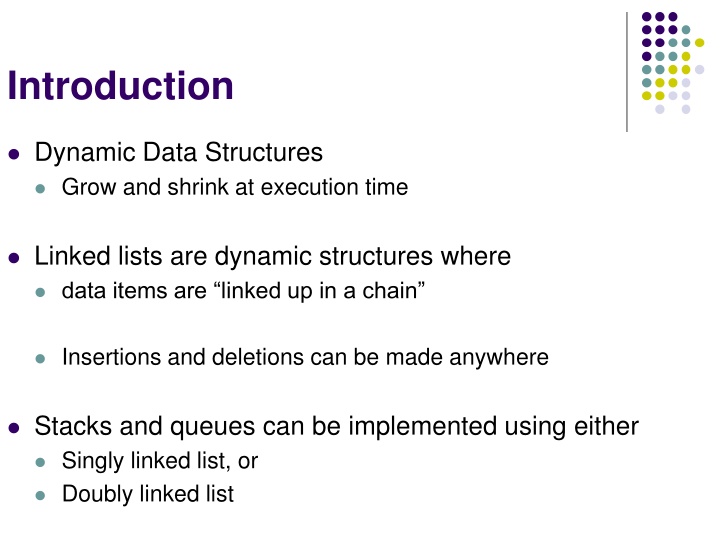
Singly Linked Lists for Dynamic Data Structures
Learn how singly linked lists, a fundamental dynamic data structure, allow for flexible insertions and deletions in a chain of connected nodes. Explore their self-referential nature, implementation in programming, and suitability for unpredictable data elements.
Download Presentation

Please find below an Image/Link to download the presentation.
The content on the website is provided AS IS for your information and personal use only. It may not be sold, licensed, or shared on other websites without obtaining consent from the author. If you encounter any issues during the download, it is possible that the publisher has removed the file from their server.
You are allowed to download the files provided on this website for personal or commercial use, subject to the condition that they are used lawfully. All files are the property of their respective owners.
The content on the website is provided AS IS for your information and personal use only. It may not be sold, licensed, or shared on other websites without obtaining consent from the author.
E N D
Presentation Transcript
Introduction Dynamic Data Structures Grow and shrink at execution time Linked lists are dynamic structures where data items are linked up in a chain Insertions and deletions can be made anywhere Stacks and queues can be implemented using either Singly linked list, or Doubly linked list
Self-referential class A self-referential class contains an instance variable that refers to another object of the same class type. For example, the generic class declaration class SNode< T > { private T data; private SNode<T> nextNode; // reference to next node public SNode( T data ) { /* constructor body */ } public void setData( T data ) { /* method body */ } public T getData() { /* method body */ } public void setNext( SNode<T> next ) { /* method body */ } public SNode<T> getNext() { /* method body */ } } // end class SNode< T > declares class Snode<T>, which has two private instance variables data (of the generic type T) and SNode<T> variable nextNode.
Singly Linked Lists A linked list is a linear collection (i.e., a sequence) of self-referential-class objects, called nodes, connected by reference links hence, the term linked list. Typically, a program accesses a singly linked list via either a reference to its first node called head, or a reference to its last node called tail By convention, the link reference in the last node of the list is set to null.
Singly Linked Lists (Contd) A linked list is appropriate when the number of data elements to be represented in the data structure is unpredictable. Refer to SinglyLinkedListApp project
Singly Linked Lists (Contd) The SinglyLinkedList<T> class Implements the SList<T> interface containing int size(), boolean isEmpty() void insertAtHead(T e), voidinsertAtTail(T e) T removeFromHead() , and T removeFromTail() methods Then, used to implement the Stack data structures, through SListBasedStack class and queue data structure, through SListBasedQueue class
Doubly Linked List A doubly linked list models a sequence of objects storing arbitrary objects It establishes a before/after relation between objects trailer nodes/positions header elements
DNode<T> class It represents a node in doubly linked list What are the properties of these Nodes ? They hold a a reference to an element object a reference to previous DNode<T> and a reference to next DNode<T> Important : it defines the relative position Before, After, First, Last
DNode<T> class (Contd) The DNode models the notion of a place in a list Within a data structure where a single object is stored gives a unified view of diverse ways of storing data in a doubly linked list Abstracts a node of a linked list (double or single) public class DNode<T> { public T element; public DNode<T> next; public DNode<T> prev; . }
Dlist<T> ADT Accessor methods: first(), last() The Dlist<T> ADT models a sequence of positions storing arbitrary objects prev(DNode<T>), next(DNode<T>) It establishes a before/after relation between positions Update methods: replaceElement(DNode<T>, T) swapElements (DNode<T>, T) Generic methods: size(), isEmpty() insertBefore(DNode<T>, T), insertAfter(DNode<T>, T), Query methods isFirst(DNode<T>), isLast(DNode<T>) insertFirst(T), insertLast(T) remove(T)
Doubly Linked List implementation A doubly linked list provides a natural implementation of the Dlist<T> ADT prev next Nodes of list store: element link to the previous node link to the next node elem node Has special trailer and header nodes Refer to DoublyLinkedListApp project header trailer nodes/positions elements
Insertion We visualize operation insertAfter(DNode<T> p, T X), which returns Dnode<T> q p A B C p q A B C X p q A B X C
Insertion Algorithm Algorithm insertAfter(p,e): Create a new node v v.setElement(e) v.setPrev(p) {link v to its predecessor} v.setNext(p.getNext()) {link v to its successor} (p.getNext()).setPrev(v) {link p s old successor to v} p.setNext(v) {link p to its new successor, v} return v {the position for the element e}
Deletion We visualize remove(p), where p = last() p A B C D A B C p D A B C
Deletion Algorithm Algorithm remove(p): t = p.element {a temporary variable to hold the return value} (p.getPrev()).setNext(p.getNext()) (p.getNext()).setPrev(p.getPrev()) p.setPrev(null) {invalidating the position p} p.setNext(null) return t {linking out p}
